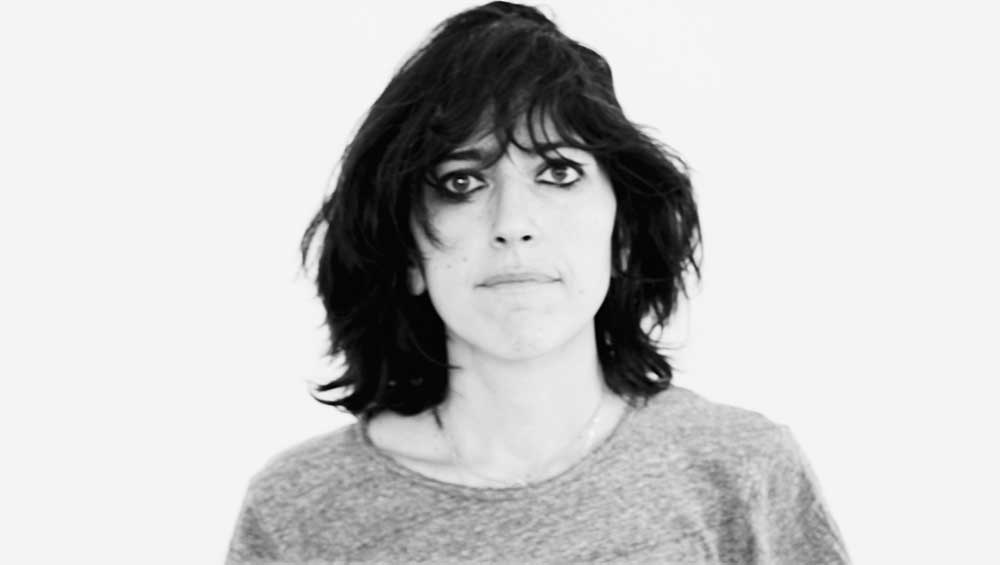
Adelaide Cioni. Photo courtesy the artist.
by ANNA McNAY
Adelaide Cioni (b1976, Bologna, Italy) uses simple forms – a cross, a triangle, a circle – and repeats them to create patterns, which she paints, draws or stitches on to fabric. In her Songs series, currently on show at Mimosa House, London, and conceived during a residency at Sol LeWitt’s former studio in Spoleto, Italy, Cioni has hung linen squares throughout the ground floor space of the gallery, making the viewer an unintentional participant in a dialogue that goes beyond verbal articulation or linguistic concept, returning to some abstract, primal idea, unencumbered by association. Upstairs, large fabric works are draped over the walls and floor, creating bright, light spaces, outside our usual existence. Three costumes hang primed – one black-and-white chequered; one with blue triangles arranged to give the effect of feathers; and one with red circles and dots, incredibly visceral and suggestive of the feminine form – ready and waiting to have life breathed into them, which occurs when three dancers come to enact a series of three separate performances, or conversations, set to music by Cioni’s collaborator, Dom Bouffard. The simplicity of Cioni’s work belies its complexity.
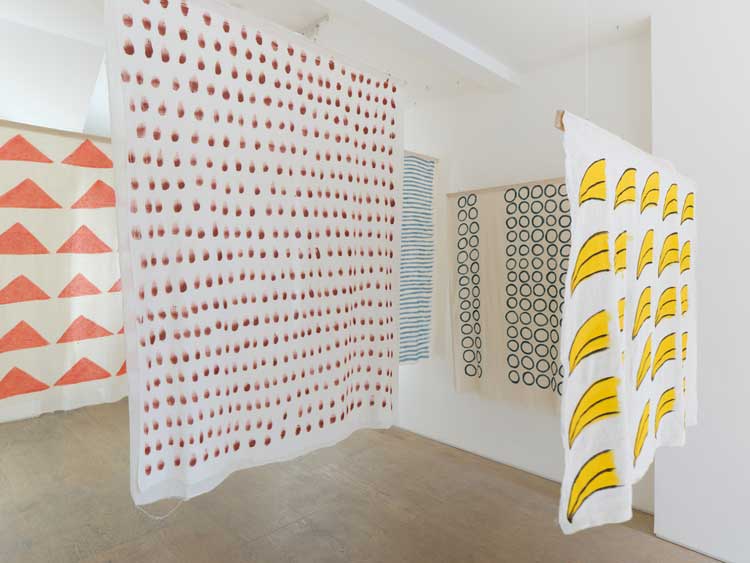
Adelaide Cioni: Ab Ovo/On Patterns. Installation view, Mimosa House, London, 2023. Photo: Lewis Ronald.
Studio International visited Mimosa House, ahead of the exhibition opening, and spoke to Cioni about pattern, translation, collaboration and artistic inspiration.
Anna McNay: Tell me about your choice of exhibition title, Ab Ovo, which means “from the egg” or “from the very beginning”.
Adelaide Cioni: I chose it because of its meaning. My practice is very much based on drawing, and this work with patterns is to do with thinking about where drawing comes from. If you think about the decorations on ceramics found in pre-historic archaeological digs, for example, I find it amazing that we were dressed in skins with nothing to our name, but we were drawing these grids, dots and triangles. It just blows my mind. And that was probably the beginning of drawing, that very first impulse to decorate an artefact with a sign – no, sorry, not a sign, a mark. My work – and the title – are really about the origins of drawing and that visual or aesthetic relation we have to objects.
AMc: Ab Ovo is also the title of a Paul Klee painting from 1917, comprising triangular, circular and crescent patterns. Did you have that in mind as well?
AC: Oh, wow, really? I love Paul Klee, but I didn’t know about that work, no.
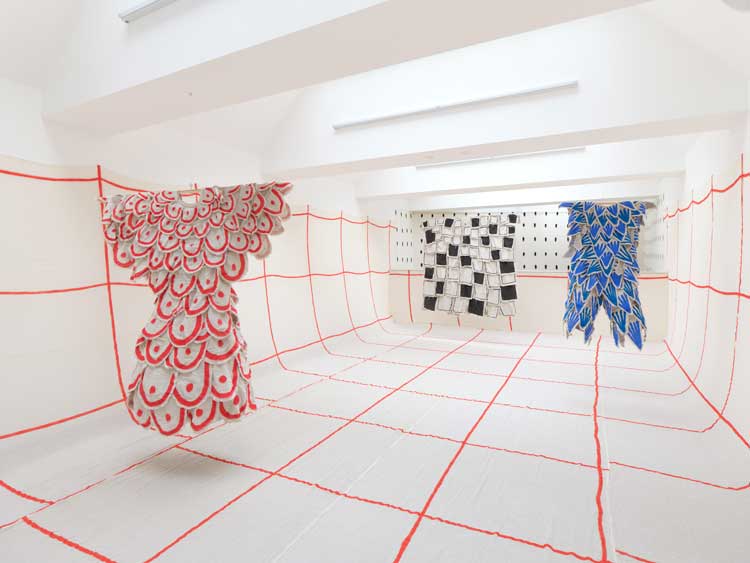
Adelaide Cioni, I am a fish. Installation view, Mimosa House, London, 2023. Photo: Lewis Ronald.
AMc: Do you see grids, dots and triangles as patterns, or shapes and forms, that existed already in nature, or are they a human invention?
AC: These shapes are very elementary. The most basic is the line. The interesting thing is that you find them recurring not just in time, but also in space. We find them everywhere, in Hawaii and in Tuscany. The only place that is different is the Aboriginal culture in Australia. I ask myself where these shapes come from, and, of course, the circle is the sun, but it’s always a balancing act as to where to draw that fine line between figuration and abstraction. Where is it that the sea becomes a wavy line and a radiator a series of slats? Exploring that boundary is always very interesting. But, yes, those basic forms come from nature.
AMc: I notice that you corrected yourself when you said “sign” rather than “mark”. Are your works purely about pattern, or do they carry meaning and symbolism as well?
AC: I don’t see these as symbols of anything, no. They are really about the mark and the vibration of the mark. The series showing downstairs in the exhibition – hanging freely throughout the space – is called The Songs, so Song of the Green Leaf, Song of the Orange Triangle, and so on. I was thinking a lot about birds singing. That’s something I very much like to tune into. I was wondering what the function of birdsong was, and, I think, it is very much to lighten up the vibrations of the whole world. It really brings our souls to a higher level. Think what the world would be like if we didn’t have birdsong – it would be a very different place indeed. So, for me, these works are very much about pattern, and, when you draw a pattern, you’re putting out your vibration – it’s like singing a song. A pattern is a visualisation of a rhythm. Music becomes an image. And, of course, the colour you choose, and shape you choose, the way you put it down, has to do with your own vibration. It’s as though you were singing a song and hearing and listening to yourself.
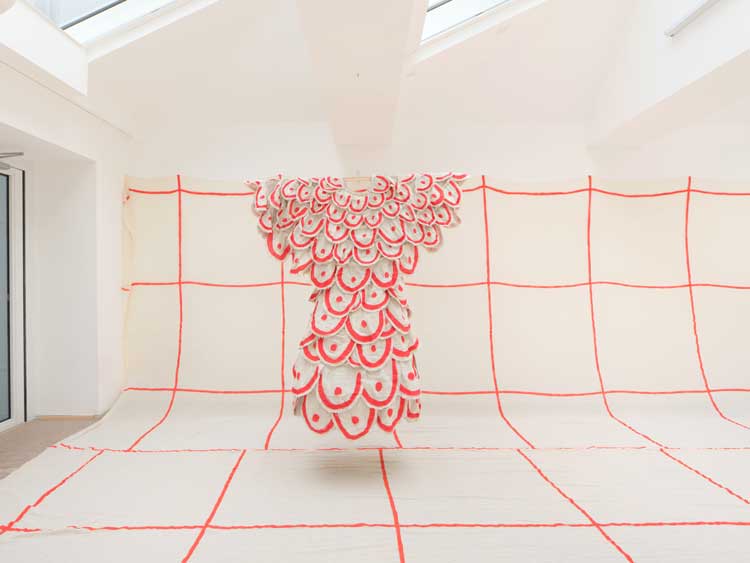
Adelaide Cioni, Costume for a Circle. Installation view, Mimosa House, London, 2023. Photo: Lewis Ronald.
Every artist looks at nature and knows they’re going to fail. You’re never going to create anything quite as beautiful or as alive. So, I thought I could try to imitate her methods. For example, think of a tree. A tree has a million leaves, and they’re all the same, but yet they’re all slightly different. When energy gets incarnated, when it becomes matter, matter implies accident, and accident means we are all a bit different. That’s why I will never use a ruler. It’s not about making a perfectly symmetrical shape; in fact, it’s about the opposite. It’s about the vibrations passing through my body. For 10 years, I worked as a translator of American literature. I translated some amazing authors. I was very lucky. And the body is a great translator. We always think of language as being something abstract, existing outside the body, whereas actually, the words you say have to be articulated through your internal organs, mouth and tongue. The body is an agent even in the words we choose. Maybe we choose certain words just because we like saying them, we like the sound of them – our bodies like them. I think that the more aware we are that we are bodies, the better we are as people, because it’s in our bodies that we feel pain and vulnerability. When we recognise that, we are more careful with other people.
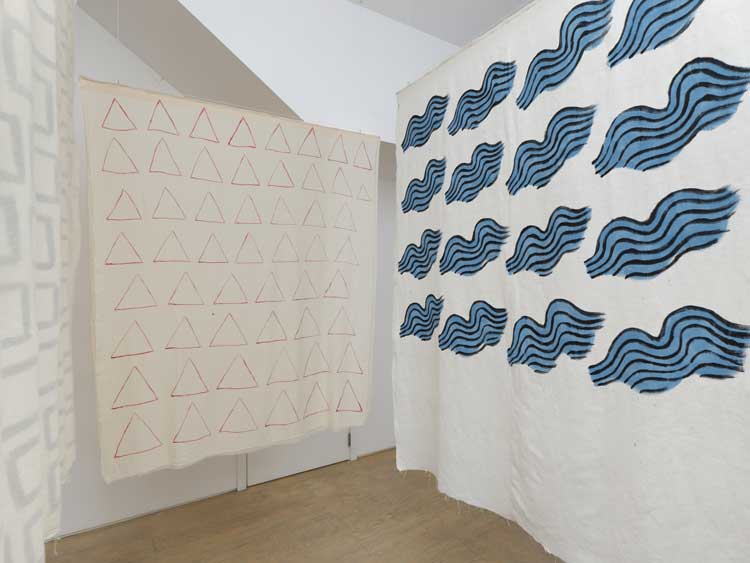
Adelaide Cioni. Song for the sea and Song for Sol, triangle. Installation view, Mimosa House, London, 2023. Photo: Lewis Ronald.
AMc: Are you separating body from mind, here, because a lot of recent research suggests that pain is in the mind?
AC: Oh, really? No, I think they are very much together. But the body is a great translator. It is what the soul needs to be in the world. The mind is a slightly different concept, but I think of the soul and the body together.
During my residency in Spoleto [in 2019], I began to collaborate with a musician, Dom Bouffard. Did you know that Sol LeWitt lived in Spoleto for several years? He bought a house there, and his daughters were born there, and he would split his time, six months in New York, six months in Spoleto. I was so lucky to get this residency and to work in his studio. I met Dom there, and he showed me his scores. They are actually drawings, using many of the elements I have been talking about, including lines and triangles. So, we decided we had to work together. This led to a lot of discussion about drawing and music and the points where they make contact. These patterns are very much related to rhythm, and so they’re both the origin of drawing, as a practice, but also probably of music.
AMc: Can you say anything about your choices of material?
AC: I always choose materials that are 100% natural. I mostly use cotton, but this can be problematic. Some of the Song pieces are on muslin. I made them in Sol’s studio, and I really wanted to do huge drawings – on the wall, but, of course, I couldn’t do that! – and so I wanted a material that was cheap and didn’t need priming. I started working with the muslin, and I really liked it, and my work got a lot bigger, as you can see from the upstairs rooms in the exhibition. It started because of a collector in Rome, who saw my work, liked it, and commissioned a huge curtain-like piece for her wintergarden. Some of the other Song pieces are on linen – flax or hemp – hand-woven by farmers. The pieces of cloth are fairly small, because the looms have to fit into their farmhouses, and so the works are made on two pieces stitched together. The farmers use this fabric for everything: tablecloths, sheets, towels ...
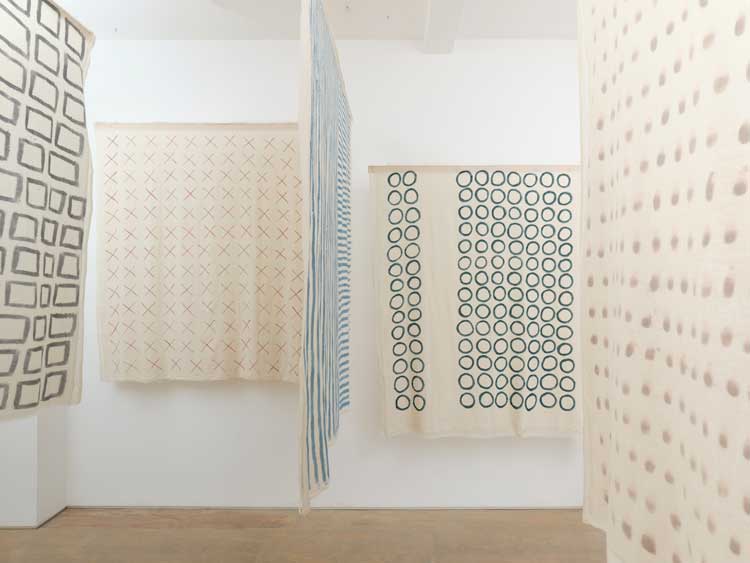
Adelaide Cioni. Songs. Installation view, Mimosa House, London, 2023. Photo: Lewis Ronald.
AMc: You have some pieces made from wool, as well.
AC: Yes, they are from the Secondary Images series, for which I handstitched wool on to the fabric. The nice thing about wool is that it appeals to your touch, it calls to the body through this tactile sense. Also, wool is not at all shiny, so the colour comes back very saturated, which is something I look for in my paintings, as well, and is why I usually use vinyl paint because it’s more matt, more opaque, than acrylic.
AMc: Do you look to any other artists for inspiration? The leaf shapes, for example, remind me of Matisse’s cut-outs.
AC: Of course, Matisse is a wonderful inspiration, I love him. Agnes Martin, too. And Pino Pascali. Then Hélio Oiticica, a Brazilian artist, who made colourful fabric works, Parangolés, which could be worn or held by people while dancing. You can see this influence in my costume pieces. I like this idea of changing the function of things – the work of art becomes a costume; and of lightness – you take the costumes off, fold them up, and they’re gone. When I was translating, I translated the catalogue to accompany a beautiful exhibition on Japanese architecture at MAXXI in Rome. I loved it because there was this wonderful idea of the precariousness of things, accepting that, taking it with you, and being light about things. That’s important to me – I like lightness also as a mood, being light in the way you approach something, being humorous about it.
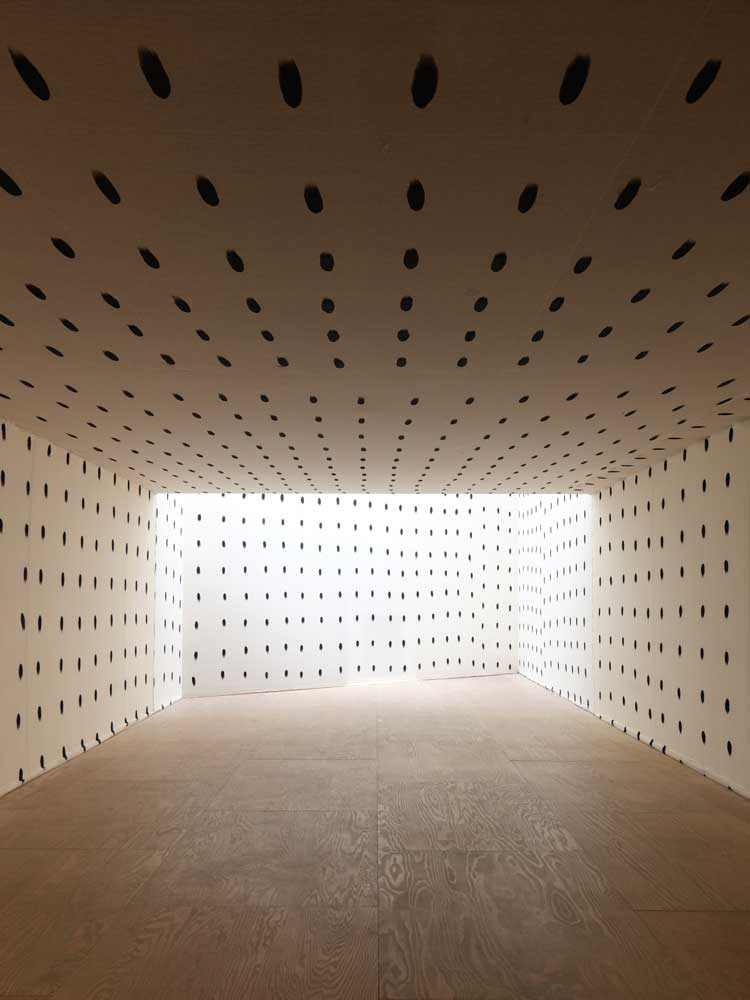
Adelaide Cioni, Rhythm in Space. Installation view, Mimosa House, London, 2023. Photo: Lewis Ronald.
AMc: What comes first for you, form or colour?
AC: They come together. They tell me how they want to be.
AMc: Would you repeat the same composition in different colours?
AC: Absolutely not, no. That shape is that colour.
AMc: Tell me about your titles. At what point does a work get its name?
AC: Sometimes they come right away, but not always. Titles are really important to me. The Secondary Images series I mentioned before came from the fact that I am always very interested in marginal things, things that mostly don’t have a story, that are never the protagonist. If you think of a painting of Apollo and Daphne, for example, the painting is of them and is telling their story. At the same time, however, your eye is recording the sea, the clouds, all these things that are around, like sediment, in a nonverbal way. When you see them again, the recognition is deeper, because they don’t have a story attached to them. They are like images that you have inside you, which don’t mean anything. I like this idea of “not meaning”, of seeing what’s beyond. I really like [Samuel] Beckett. In fact, one thing that’s important about pattern, when you have a whole wall of crosses, for example, is that it’s speaking to you. It’s speaking for hours, but it’s not telling any story. We create stories to make sense of things, to make sense of death, of the end of time. If you step out of storytelling, you access another dimension, which isn’t temporal. I think abstraction and repetition can take you there.
AMc: That’s really interesting in relation to translation theory, too. When you encounter ideas like this, abstract concepts that have no meaning, nonsense language, or sometimes even poetry, the question is how are you to translate them? For example, do you try to confer the phonetic form in the absence of semantics?
AC: Absolutely. When I was translating, I really loved it whenever there was an experimental text that brought you to the verge like that. Those were always the most interesting things to translate. That is what is so exciting about language.
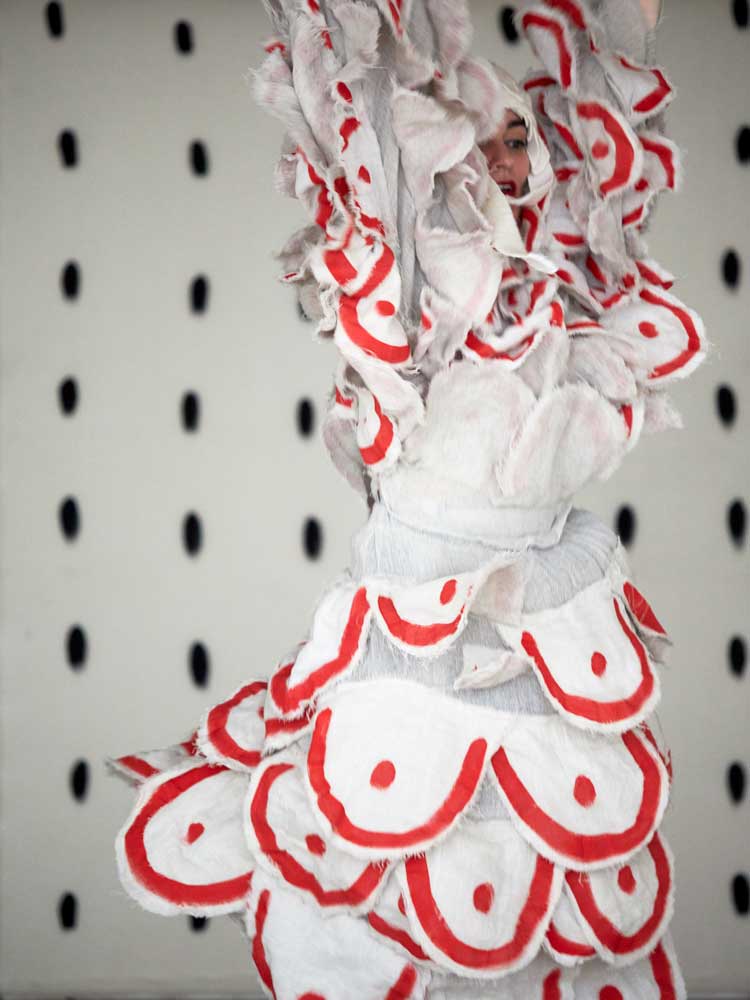
Song for a Square, a Circle, and a Triangle. Performance, Mimosa House, London, 2023. Photo: Tim Smyth.
AMc: In a way, your patterns are a form of pictorial language. A universal language.
AC: Yes, exactly. When you look at a pattern, you’re tapping into a common language. I feel as if something inside me is dissolving, finding a moment of rest, of peace. I think there is an alphabet that we all share, that we have inside us, that we see when we look at Matisse, but also at Nigerian textiles. It’s something very deep inside. I think everybody feels like this – or maybe not?
AMc: Can you tell me about the film work you are showing in the exhibition?
AC: It’s a Super 8 projection I did in January 2019 when I was living in Kew, in south-west London, for a month. I decided I would work in Kew Gardens, in the palm house, which was amazing – and warm. It’s called Kew: A Conversation in Green. I also did several sketches of the palms, and then I realised afterwards how much they are linked to the patterns.
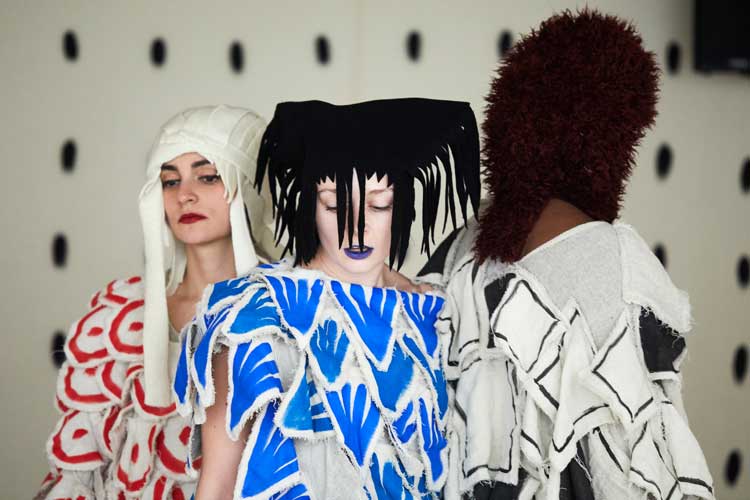
Song for a Square, a Circle, and a Triangle. Performance, Mimosa House, London, 2023. Photo: Tim Smyth.
AMc: Finally, you have mentioned both your collaboration with Dom Bouffard and your costume pieces. Can you say something about the performance aspect of your work?
AC: It came from the collaboration with Dom. I was doing a residency at Gasworks last year, and they asked me to do a performance. I was already working on this series, and I thought maybe I could make a pattern in the form of a costume and have a conversation with Dom and a dancer to see how they would respond to it. It was amazing to see a drawing that I had made become three dimensional and move in space to music. The performances are called Song for a Square, a Circle, and a Triangle, and there are three different costumes, three different dancers, and Dom did different music for each of them. They are very distinct. Through improvisation and rehearsals, each of the dancers has found her own way to express that shape and that colour. They are amazing dancers, and I’m very happy. Dom and I would like to do an album of the music, and our ultimate goal is to create a parade with 12 dancers and 12 different costumes, but you need a lot of money to do that.
• Adelaide Cioni: Ab Ovo/On Patterns is at Mimosa House, London, until 25 April 2023.